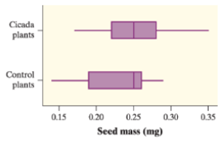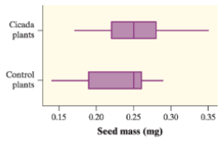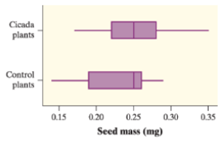
Concept explainers
(a)
To Explain: a few sentences comparing the distribution of seed mass for the two groups of plants.
(a)
Answer to Problem AP2.24CPT
Skewed with the same centre and a higher spread for the cicada plants
Explanation of Solution
Given:


By seeing the distribution, it is observed that the distribution of the cicada plants is slightly skewed to the right, where the distribution of the control plants is skewed to the left.
Centre: The median would be the same for both of the distributions, where the mean is slightly higher for Cicada Plants.
Spread: the cicada plants have a large spread, where the box plot is wider.
Outlines: neither distributions appears to contain outliers as there are no “
(b)
To find: the distribution likely has the larger mean.
(b)
Answer to Problem AP2.24CPT
Cicada plants group
Explanation of Solution
Given:


In the previous part (a), it is concluded that the control plants group contained more skewed. Since the mean is strongly influenced by skewed the mean is too more influenced by the left-skewed in the control plants distribution, since a left-skewed distribution contains unusually small values, these small values will decrease the mean and therefore the mean of the control plants group will be lower than the mean of the cicada plants group.
(c)
To Explain: the purpose of the random assignment in this study.
(c)
Answer to Problem AP2.24CPT
For the surety that the two groups are as similar as possible, prior to the experiment
Explanation of Solution
Given:


The random assignments to the groups ensure that the two groups are as similar as possible prior to the experiment and then it also knows that the results of the experiment are due to the treatments.
(d)
To Explain: the name one benefit and one drawback of only using American bellflowers in the study.
(d)
Answer to Problem AP2.24CPT
Advantage: differences between control group and treatment are small
Disadvantage: result of experiment cannot be generalized to other flowers.
Explanation of Solution
Given:


A benefit is that the differences between the treatment and control group will be very small, because all flowers will be of the same type.
A drawback is that you will only have data for one type of flower and therefore the results of the experiment could not be generalized to other flowers.
Chapter 7 Solutions
PRACTICE OF STATISTICS F/AP EXAM
Additional Math Textbook Solutions
Statistics for Psychology
An Introduction to Mathematical Statistics and Its Applications (6th Edition)
Intro Stats, Books a la Carte Edition (5th Edition)
Elementary Statistics (13th Edition)
Elementary Statistics Using Excel (6th Edition)
Elementary Statistics: Picturing the World (6th Edition)
 MATLAB: An Introduction with ApplicationsStatisticsISBN:9781119256830Author:Amos GilatPublisher:John Wiley & Sons Inc
MATLAB: An Introduction with ApplicationsStatisticsISBN:9781119256830Author:Amos GilatPublisher:John Wiley & Sons Inc Probability and Statistics for Engineering and th...StatisticsISBN:9781305251809Author:Jay L. DevorePublisher:Cengage Learning
Probability and Statistics for Engineering and th...StatisticsISBN:9781305251809Author:Jay L. DevorePublisher:Cengage Learning Statistics for The Behavioral Sciences (MindTap C...StatisticsISBN:9781305504912Author:Frederick J Gravetter, Larry B. WallnauPublisher:Cengage Learning
Statistics for The Behavioral Sciences (MindTap C...StatisticsISBN:9781305504912Author:Frederick J Gravetter, Larry B. WallnauPublisher:Cengage Learning Elementary Statistics: Picturing the World (7th E...StatisticsISBN:9780134683416Author:Ron Larson, Betsy FarberPublisher:PEARSON
Elementary Statistics: Picturing the World (7th E...StatisticsISBN:9780134683416Author:Ron Larson, Betsy FarberPublisher:PEARSON The Basic Practice of StatisticsStatisticsISBN:9781319042578Author:David S. Moore, William I. Notz, Michael A. FlignerPublisher:W. H. Freeman
The Basic Practice of StatisticsStatisticsISBN:9781319042578Author:David S. Moore, William I. Notz, Michael A. FlignerPublisher:W. H. Freeman Introduction to the Practice of StatisticsStatisticsISBN:9781319013387Author:David S. Moore, George P. McCabe, Bruce A. CraigPublisher:W. H. Freeman
Introduction to the Practice of StatisticsStatisticsISBN:9781319013387Author:David S. Moore, George P. McCabe, Bruce A. CraigPublisher:W. H. Freeman





